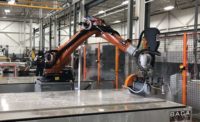Dekton, among other alternative stone materials, continues to grow in popularity for applications such as countertops, flooring and both interior and exterior wall cladding. Being a hard dense product, it is crucial that the appropriate tooling is used during the fabrication process. Valentin Tijeras Garcia, product and R&D corporate director for Cosentino Group, provides several important tips of advice for those working with compact sintered stone.
SW: First a general overview. Why do products such as Dekton need special/different tools than those that are used for cutting granite and marble?
VTG: Material hardness is the key to understanding why you need different tools to fabricate Dekton. The material has a very high density (ultra-compact), which means that if you don’t use proper tools, you can either break the tool or the material, or even worse, damage the machinery.
SW: As far as cutting the material, what difference is there in the cutting process compared to natural stone? I assume feed rate, water rate, etc.?
VTG: The cutting process requires trimming the edges to release tensions. Then you have to follow cutting recommendations, which includes using plenty of water, the proper speed and feed rate, etc. Once you follow the rules, it’s a piece of cake.
SW: When doing edging on Dekton, same question. What is the difference in the process compared to a natural stone?
VTG: In this sense, Dekton’s edge is very easy to work with since the material is very homogeneous, and it is easy to get very good results. Any fabricator can do it well at first attempt.
SW: What are some common mistakes that fabricators are making when it comes to cutting this material? Also, what are some common mistakes with doing edging or doing sink holes or something
like that?
VTG: The main mistake is trying to fabricate Dekton as if it was a granite or quartz composite. If you use the same tools, speed rates and so on, you will fail. Another common mistake is trying to cut Dekton in a support that is uneven. It is a common source of problems too.
SW: Any other issues and solutions you want to mention when cutting/working with Dekton?
VTG: Sometimes people ask about what machine is best to cut Dekton. In my opinion, the key is not the machine but the tools and proper maintenance. I have seen people with very modest equipment doing amazing things, and also the other way around.
SW: Anything else that I didn’t ask that you would like to point out when it comes to tooling needed for cutting alternative stone material such as Dekton?
VTG: Tool manufacturers do an amazing job and they are improving day in day out. I strongly recommend that you talk to them and follow their advice.








